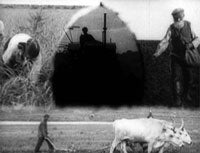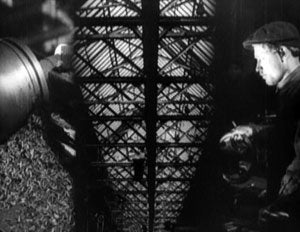One of the central tenants of modernist film and photography is the use of extreme camera angles. Whether members of the so-called “New Vision” of the Bauhaus in Germany, the Italian Futurists or the Russian Constructivists, these photographic artists hoped to break out of the same old tired viewing habits based on central perspective, in order to depict reality in new and surprising ways. Extremely high or low angles (worm’s or bird’s eye views) forced moviegoers to renegotiate space, to analyze what they were seeing, to become conscious of an image’s meaning, to think rather than passively consume.

I was reminded of this when watching Dziga Vertov’s feature length “documentary,” A Sixth Part of the World (1926), which is a part of our series “Kino-Eye: The Revolutionary Cinema of Dziga Vertov" at the Billy Wilder Theater, brought to us by our colleagues at MOMA and the Östereichisches Filmmuseum, and curated by Yuri Tsivian. Not only does Vertov constantly thwart our expectations by showing us uncommon views of everyday objects and events, thus forcing us to look more closely, he also composes images on a formal-kinetic, as well as on a semantic level.
In fact, from the first title onwards, Vertov uses images like words, and words like images. Not until 40 years later would Jean-Luc Godard and Chris Marker pick up where Vertov left off in speaking to their film audiences as essayists. All of Vertov’s titles use constructivist design to dynamically engage the viewer, through layout and typography, changing size and placement of individual words for emphasis and legibility. Furthermore, the titles address the audience directly and call them to action: “YOU!” Vertov says repeatedly and means the viewer. Calling his work a "cine-poem,” Vertov employed the repetition of words and images lyrically in a way that had never been seen before. Marker’s masterpiece, Sans Soleil (1983), is unthinkable without Vertov.

Indeed, one could argue that Vertov created the grammar of film for both documentary and avant-garde film practice. At a time when Hollywood was still perfecting its seamless mode of address, codified in classical Hollywood narrative, enveloping the viewer in a story that promoted mindless consumption over thought, Vertov insisted on an active reading of his work. Dynamic compositions, fast and slow-motion, split screens, multiple exposures, stop-action animation, rapid editing, editing on form, extreme camera angles—all had been used at various points for fictional films, but Vertov applied the techniques to images shot in the real world.
Vertov went further than all his contemporaries, including Walter Ruttman, Alberto Cavalcanti and other avant-garde documentarists of the 1920s in his treatment of the film material itself. Any image was game for Vertov’s intellectual montage. The opening of A Sixth Part of the World depicts the excesses of capitalist consumption and its reliance on exploiting Third World peoples to maintain its insatiable needs. Vertov intercuts found footage, taken mostly from German fiction films, but also newsreel footage shot by Western cameramen in Third World countries. He also interpolates a shot from an American western, claiming the horse and wagon are in the Russian steppes. In other words, Vertov takes a postmodern attitude towards his raw material, because meaning for Vertov was constructed through the juxtaposition of images, not as a result of their origins. Given that Vertov's editor and wife, Elizaveta Svilova, was probably friends with Esfir Shub, who reedited all foreign films for Russian consumption (and invented the found footage documentary), it's not surprising that we find this American buckboard in Vertov’s film. But it also makes Vertov very modern.
"Vertov died persona non grata in the Soviet Union, condemned as a formalist by the Stalinists."
In A Sixth Part of the World, Vertov argues that while capitalist economies exploit Third World people of color, the new classless Russian society will help the Soviet Union’s own rainbow of ethnic minorities bring their goods to market without getting screwed, and eventually Communism will eliminate all ethnic differences. This, of course, didn’t quite work out that way, and eventually Vertov died persona non grata in the Soviet Union, condemned as a formalist by the Stalinists.
35 years later during Perestroika in 1990, I attended a Russian American film conference, where Vertov, previously rehabilitated by the Communists in the 1970s, was accused by young Moscovite film journalists of being a propagandist responsible for the genocide of millions under Stalin.






 Mobile Navigation
Mobile Navigation

